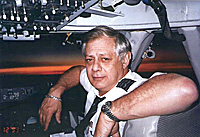By Morris Malakoff, JTNews Correspondent
The military mythology of modern Israel is filled with stories of dramatic acts of aerial gallantry and daring maneuvers in defense of the state. But sometimes the most courageous acts are in the strict service of individuals.
The life story of Arieh Oz is one filled with those acts — both in service to him and by him.
Oz was born in Germany in 1936. His father had left his family behind in 1938 to get a foothold in Palestine. But before the elder Oz could send for Arieh, his mother and sister, Germany became unlivable for Jews.
With his mom and sister, he fled to the Netherlands, only to be forced into hiding with a gentile family near Utrecht for two years when the Germans occupied the country in 1942.
“We were on the list to be sent to Auschwitz,” said Oz from his current home near Tel Aviv. “I once had to be secretly moved to Friesland to avoid the Germans.”
In 1946, his family was reunited in Palestine and opportunities to return the favor of being saved would present themselves many times over the next 40 years.
“I struggled to assimilate in Israel,” he said. “I did finish high school and the Israeli Air Force found me and sent me to flight school in 1956.”
The timing of his flight education put Oz in the air in every military action of the IDF between the Suez to the first foray in Lebanon in 1982. But two events would become the hallmarks of a man who flew not the sleek and glamorous fighter jets of the Israeli Air Force, but the lumbering transport aircraft, the supporting cast of any military.
“I was called up to the reserves in 1976 for a specific mission,” he said. “I flew a Hercules plane from Israel to Entebbe, in Uganda.”
In the belly of his plane were troops sent to rescue 100 Jewish passengers that had been on board a hijacked Air France flight.
“I had been to Entebbe many times; we had a training school there,” he said. “But we were coming in on a new runway, so that was irrelevant.”
His plane was the third to land as part of Operation Thunderbolt. That meant the element of surprise had evaporated by the time his plane was over the runway — and the hostages’ captors meted out consequences.
“When we were 300 feet over the runway, the runway lights were turned off,” he said. “That meant an interesting landing.”
Still, the night raid was a success and has taken a place of honor in the pantheon of great Israeli military missions.
Oz’s second great mission doesn’t have the notoriety of Entebbe, but its humanitarian nature makes it no less of an act of greatness.
“After I retired from the Air Force, I went to work for El Al and became chief pilot,” he said. “In 1991, I flew the first 747 to land in Addis Abba.”
That flight was part of Operation Solomon, an airlift that brought more than 14,000 Ethiopian Jews to Israel in a 36-hour period.
“We were using both El Al planes and military aircraft,” Oz said. “I was supposed to carry 760 people on that flight, but one of the Hercules had an engine not working. We put 1,081 people on that plane for the flight.”
“We had people sitting in the aisles, in the lavatories, anywhere they could find to put their tuches,” he said. “Taking off wasn’t a challenge because of all the people, but because the altitude of Addis Abba is 7,500 feet. We lightened the fuel in the plane so that we had enough to get to Tel Aviv, just over three hours away.”
That many passengers on one plane set a record that eventually made it into the Guinness Book of World Records.
Oz, who will speak at the Museum of Flight in South Seattle on Sept. 7, says that his experiences have made him a strong supporter of an IDF that defends both state and individual.
“There is that saying about ‘when the Arabs put down their arms, there will be peace; when Israel puts down hers, there will be no more Israel,’” he said. “I truly believe that and that our mission is vital and never-ending.”
Today, Oz lives with his wife, Bat Sheba, and owns an aviation consulting practice that works with the Aviation Authority in Israel.
